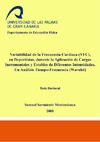Please use this identifier to cite or link to this item:
https://accedacris.ulpgc.es/jspui/handle/10553/2012
| Title: | Variabilidad de la frecuencia cardiaca (VFC), en deportistas, durante la aplicación de cargas incrementales y estables de diferentes intensidades: un análisis tiempo-frecuencia (Wavelet) : tesis doctoral | Authors: | Sarmiento Montesdeoca, Samuel | Director: | García Manso, Juan Manuel Martín González, Juan Manuel |
UNESCO Clasification: | 241106 Fisiología del ejercicio | Keywords: | Deportes Medicina deportiva |
Issue Date: | 2008 | Abstract: | Con el paso de los años, en el campo del entrenamiento deportivo, se han aplicado diferentes protocolos e instrumentos de valoración funcional con el fin de controlar las cargas de trabajo aplicadas al deportista. Por ello, entendemos necesario buscar y desarrollar herramientas mas fiables y menos costosas, además de metodologías poco agresivas y sencillas de aplicar para el control funcional del deportista ante la aplicación de diferentes cargas de trabajo. En nuestro caso, nos centramos en el control de la respuesta funcional cardiaca del deportista, y más concretamente del comportamiento variable de los tiempos entre cada latido (VFC). Según el comportamiento no-estacionario que muestra esta señal ante la aplicación de diferentes intensidades de esfuerzo, se ha hecho necesario emplear metodologías basadas en el dominio tiempo-frecuencias para analizar dicha variable. El objetivo principal de este trabajo era estudiar el comportamiento de la VFCdurante la aplicación de diferentes cargas de trabajo (crecientes y mantenidas) a partir de la aplicación de un análisis tiempo-frecuencia como es el análisis de la transformada wavelet. Para ello, la hipótesis experimental de partida consistía en afirmar que la VFCanalizada mediante metodologías wavelet, era una herramienta útil y eficaz para el estudio del estado funcional del deportista al aplicar las cargas de trabajo. Con el fin de verificar la hipótesis inicial, se utilizó equipo de análisis de ritmo cardiaco y otro de análisis de gases, así como una muestra compuesta por 12 ciclistas de élite para la realización de cuatro pruebas de esfuerzo en laboratorio. Los resultados más relevantes nos permiten comprobar la elevada sensibilidad de la VFC, analizada mediante técnicas lineales en el dominio tiempo-frecuencia ante la aplicación de cargas de trabajo; así como los elevados índices de correlación y acuerdo entre los métodos de análisis ventilatorios con respecto al método propuesto en este trabajo. La conclusión principal de la investigación presente, se traduce de forma resumida en que la metodología de análisis wavelet de la VFC, proporciona una detallada y precisa resolución de los cambios producidos en frecuencias y tiempo, los cuales nos permiten localizar transiciones de fases de forma simultánea cuando se somete al organismo a un esfuerzo. Over the years, in the field of sports training, have applied different protocols and tools for functional assessment in order to control workloads applied to the athlete. Therefore, we understand and develop tools necessary to seek more reliable and less expensive, as well as methodologies little aggressive and simple to apply for the functional control of the athlete before the application of different workloads. In our case, we focus on the control of the functional response of cardiac athlete, and more specifically behavioral variable time between each beat (HRV). According to the non-stationary behavior shows that this signal to the application of different intensities of effort, it has become necessary to employ methodologies based on the time-frequency domain to analyze this variable. The main objective of this work was to study the behavior of HRV for the implementation of different workloads (growing and maintained) from the application of a time-frequency analysis as is the analysis of the wavelet transform. To that end, the experimental hypothesis was heading say that the HRV analyzed using wavelet methodologies; it was a useful and effective tool for the study of functional status of the athlete when applying workloads In order to verify the initial hypothesis was prepared by a team of analysis of heart rate and other gas analysis, as well as a sample of 12 elite cyclists for the realization of four tests in the laboratory effort. The most relevant results allow us to check the high sensitivity of HRV, analyzed using linear techniques in the time-frequency domain before the application of workloads; as well as the high levels of correlation and agreement between the methods of analysis with respect to ventilatory method proposed in this paper. The main conclusion of this investigation, resulting in summary that wavelet analysis methodology of HRV, provides a detailed and accurate resolution of the changes in frequency and time, which allows us to locate phase transitions simultaneously when the body is subjected to a force |
Description: | Programa de doctorado: Salud, actividad física y rendimiento deportivo | Department: | Departamento de Educación Física | Faculty: | Facultad de Ciencias de la Actividad Física y el Deporte | URI: | https://accedacris.ulpgc.es/handle/10553/2012 | ISBN: | 978-84-692-1859-4 |
| Appears in Collections: | Tesis doctoral |
Page view(s)
564
checked on Mar 1, 2025
Download(s)
6,481
checked on Mar 1, 2025
Google ScholarTM
Check
Altmetric
Share
Export metadata
Items in accedaCRIS are protected by copyright, with all rights reserved, unless otherwise indicated.
